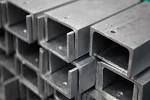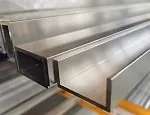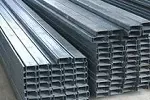Various steel products for building
Flat steel and cross bars are welded or pressure-locked together to create steel grating, also known as metal or bar grating.The two types of construction use twisted square, round, or flat steel for the cross bars. Carbon steel with a galvanised finish is commonly used for these gratings, while stainless steel is also an option.
- Steel Beam
A steel beam is a common structural element in various contexts. Upon first glance, you may notice that their face is formed like an uppercase letter I. Since steel beams are so robust but so cumbersome, they are commonly split down the middle to make tee beams (in the shape of a capital T).
Steel beams are extremely strong and are mostly used for sustaining weight. In particular, they are frequently utilised in bridge supports and principal building frames in construction and civil engineering.

- Aluminium Extrusion
Aluminium extrusion is a process in which an aluminium alloy is forced through a die with a specific cross-sectional shape. A heavy ram forces the metal into the die and comes out the other side. The object emerges from the machine as the dice and is transported along a runout table. Aluminium extrusion Singapore has gained significant traction in product development and production recently.
- Expanded Metal Mesh
Pressing sheet metal through an expanding machine that cuts it into a pattern before spreading it apart yields the expanded metal mesh. The holes appear at the points where the mesh was cut or remain solid and homogeneous. Heavy-duty wire mesh manufactured from expanded metal is far more long-lasting than other types of wire mesh. Because of this, it is more durable and simpler to weld. It's an improved option for jobs that need temperature control as it provides greater ventilation than perforated sheet metal. Compared to sheet metal, it's lighter, cheaper, and generates less waste during manufacture.
- Slotted Angle Bar
Slotted angle, or slotted angle iron, is a system of reusable metal strips used to make shelving, frames, work benches, and equipment supports. This is the most common method of bending bars, as it is used for most bending tasks. Punching and turning them with a V-shaped die, slotted angle bar is formed. The angle bar is placed over the V-die, and the bending punch exerts a force.
- Lip Slit

Wide varieties of steel are used in the cold forming of lip channel. Roll-formed lipped sections are often made from Hot Rolled Mild Steel or Z275 Pre-Galvanized Steel, two of the most common steel kinds. Lip channels are made from corrosion-resistant steels that are cold-forged for maximum durability.
- Unistrut
The technical term for a category of systems whose primary use is to suspend objects from a roof or a wall? Unistrut is a robust system built for stopping wire rods and support brackets. All sorts of products, equipment, cables, etc., can be hung on and supported by unistrutSingapore, making it a useful tool for various trades.
Conclusion
Steel grating is an essential component in many commercial and industrial environments. Although steel beams may appear basic at first glance, a wide range of forms, variations, measurements, and more are designed for specific uses. Producing components with unique cross-sectional profiles requires the aluminium extrusion process.
A Detailed Explanation of Aluminum Plates
When raw aluminium is subjected to extreme pressure during the pressing and rolling processes, the outcome is aluminium sheets, also known as aluminium plates. Thin and lightweight, yet strong enough to give a wide range of design options and low maintenance requirements, this is the hallmark of aluminium sheeting. Its many other desirable qualities have led to its extensive use in various commercial, agricultural, domestic, and commercial production settings.
Aluminium sheets, with various extra coatings applied, can be made into a durable material suitable for outdoor usage or in other harsh conditions, such as external cladding. Because of their low weight, very thin aluminium sheets are perfect for high-volume storage, transit, and retail applications.
How do aluminium sheets become manufactured?

Raw bauxite, an ore typically found in thick clay-like soil types a few metres below the earth's surface, is today's only source of aluminium extraction. White alumina, an oxide powder, is created by processing this ore in a hot lime and caustic soda solution. This oxide generates the liquid metal at very high temperatures, often called aluminium, when coupled with electricity and carbon (to create CO2).
This liquid metal fabrication Singapore is cast into various ingots or alloys depending on its final use. Bars of up to 20 feet in length (and 20 tonnes in weight!) with exceptionally formable (ductile) qualities are typical for aluminium used for tubes, rods, sheets, and angles. They may be rolled or pressed to practically any usable thickness by subjecting them to different temperatures and pressures, allowing for the sheet metal fabrication Singapore and plates, foils, and other forms.
What do you do with aluminium sheets?
- Roofing
Aluminium roofing sheets are one of the most common uses for larger panels. This is largely attributable to the fact that aluminium roofing sheets have a construction that is not only lightweight but also very durable and has outstanding anti-corrosion capabilities.
- Artistic ceilings
Beautiful and long-lasting deboned or composite aluminium sheets are frequently utilised as ceiling perforated panel or huge tiles inside buildings.
- Balconies
Again, due to its lightweight yet sturdy, metal works Singapore construction and their extreme weather proofness, aluminium balcony railings and fences are often used.
- Cable sheathings

Aluminium foils and other extremely thin sheets of aluminium are often used to create metal perforated sheet sheathing for cable due to their amazing mechanical and electrical qualities and their relative resistance to corrosion (which can be improved via several additional treatments).
- Shelters
Covered pathways and public and private outdoor shelters are common uses for aluminium panels in worldwide.
- Caravans
Aluminium plate or sheeting is frequently used in the construction of towable storage and lodging due to its lightweight and high resistance to the effects of weathering in exposed places.
- Flooring and walls
While decorative and structural aluminium sheet walls are becoming increasingly popular as hardwearing, beautiful, and readily cleaned fixtures in the home or workplace, aluminium plates can be chequered to provide greater anti-slip and damage-masking capabilities, suitable for usage in high-traffic areas.
Conclusion
Aluminum is a great choice for projects that need a lightweight material. Although uncoated, this metal sheet Singapore has exceptional corrosion resistance. Aluminum's strength comes from its low density and ability to be machined, welded, and sliced with a laser from Metal Supplier Singapore.